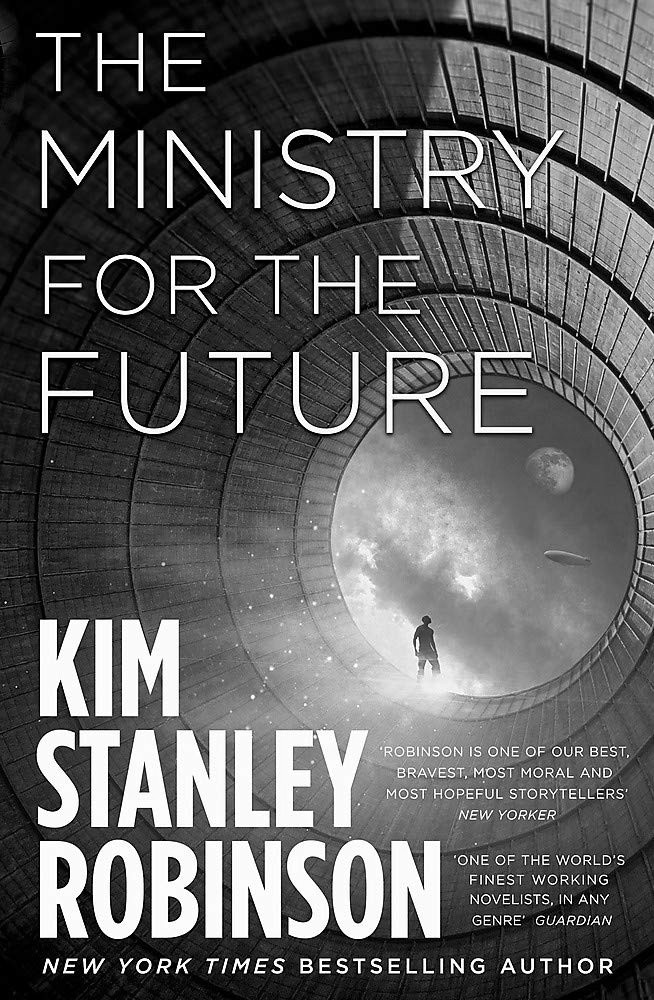Tim Middleton reflects on Kim Stanley Robinson’s latest novel and the inherent dangers of a global eco-religion.
Kim Stanley Robinson, The Ministry for the Future, published by Orbit, 2020.
ISBN: 978-0-316-30013-1
I have recently finished reading Kim Stanley Robinson’s 2020 novel The Ministry for the Future. Set in the 2020s, 2030s, and 2040s, the story loosely follows the activities of a new UN agency tasked with representing the interests of planetary citizens. Catastrophes abound, including shocking heatwaves, financial upheavals, and several acts of ecoterrorism. Slowly, however, over the course of the novel, Robinson imagines a world in which levels of atmospheric carbon dioxide turn a corner, begin to fall, and the threat of ecological breakdown is averted.
In some ways, The Ministry for the Future offers a comparatively hopeful vision. It certainly differs from those examples of cli-fi (climate fiction) that dwell on apocalypse and doom. And yet, I still found Robinson’s book deeply unsettling. I think part of my unease can be put down to the literary form. In suitably postmodern style, fragments of non-fiction and meditation are interspersed with perspectives from a wide range of characters. The resulting sense of disjunction is presumably deliberate.
However, on reflection, what I found most disturbing of all was how Robinson imagined that the planetary community might bring the ecosphere back from the brink. The sheer scale and audacity of some of the societal and geological projects involved are frankly mind-boggling. Glaciers all round Antarctica are drilled to remove the meltwater from their bases, disrupting their accelerated movement, and slowing the rate of Antarctic ice sheet collapse. The whole of the Arctic ocean is dyed yellow to prevent the dark seawater from absorbing so much heat. Many oil executives are assassinated. And terrorist attacks all but halt international air travel.
These activities are not in themselves surprising. But there are intense ethical conversations to be had about the legitimacy of such actions. How would we ever come to global agreement on such controversial subjects? Who finally decides that the Arctic ocean ought to be yellow?
Inasmuch as the Ministry for the Future bears some responsibility for coordinating these different responses, an actor is identified. But the idea that one single body—the ministry—could ever enjoy universal support of this kind feels unimaginable. Robinson is very aware of this concern. And in his imagined scenario, unilateral action by states, corporations, and even lone individuals is included too. It is not, in the end, the ministry that brings about change, but an eclectic assortment of actors—from bankers to drone pilots.
So, what role—if any—might religion have in all of this?
Throughout the novel, one of the key figures at the Ministry for the Future, muses about the possibility of a global religion that could unite people behind a single vision of ecological flourishing. What this character recognises in religion is the immense potential to bring people together around a common moral cause. Such a global eco-religion never materialises. But the character in question does reflect, somewhat whimsically, at the end of the book about how he still thinks such a religion would be a good idea.
What does happen instead is a global ‘Gaia moment’, where everyone on the planet is invited into a single moment of meditation and contemplation in gratitude for some of the progress that has been made. It is hard to imagine hard-nosed pragmatists taking part in such an apparently hippy festival, but Robinson implies that the initiative nonetheless gained traction. He narrates this event from the perspective of an Hawaiian islander who must stay up until 3am to be part of this global moment. The islander is not too sure that the experience amounts to much, and yet he does feel a sense of cosmic connection the following day whilst out surfing. The reader is left wondering whether a global moment of union was ever really achieved.
The message is subtle, but, I think, vitally important. Robinson, in effect, communicates his suspicions about any religious visions that claim to have global relevance and global reach. We know only too well about the many colonial atrocities that have been committed in the name of apparently universal worldviews. No religion is really going to be able to unite and motivate all people in all places.
In The Ministry for the Future, Robinson makes common cause with the work of Bruno Latour. In his book on Facing Gaia Latour sounds a warning against false totalities. Any claim to have a complete vision of how the future ought to be—even if that vision is propounded by a trustworthy UN agency in the name of ecological protection—should be treated with suspicion. And the same goes for any eco-religion. A monistic perspective on global flourishing is a form of idolatry because it puts ourselves in the driving seat with a supposedly god’s-eye view. Such universal visions are really rather terrifying.
In other words, I think we should indeed be feeling highly ambivalent about the idea of a Ministry for the Future. On the one hand, such an institution could coordinate exactly the sorts of actions that are so urgently needed. But, on the other hand, any Ministry for the Future risks becoming totalising and controlling.
What we need instead are many ministries for the future. The future must be built piece by piece from the bottom up. Each of us could, in our own way, contribute a different ‘ministry for the future’.

Discuss this